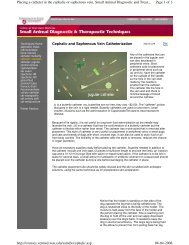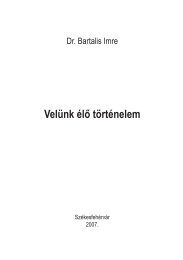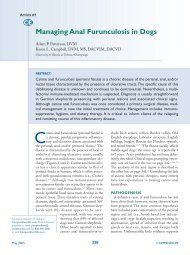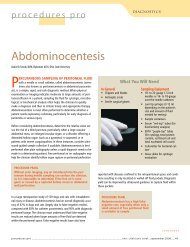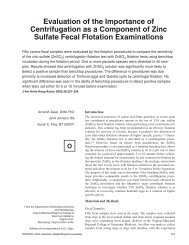Diabetic Ketoacidosis - Hungarovet
Diabetic Ketoacidosis - Hungarovet
Diabetic Ketoacidosis - Hungarovet
Create successful ePaper yourself
Turn your PDF publications into a flip-book with our unique Google optimized e-Paper software.
<strong>Diabetic</strong> <strong>Ketoacidosis</strong> Veterinary Technician January 2001 17<br />
ed with fluid therapy. Although the animal’s serum potassium<br />
concentration may initially be decreased, normal, or<br />
elevated, the patient’s total body stores of potassium may<br />
actually be depleted. Insulin therapy will drive serum<br />
potassium into the cells, causing a lowering of serum<br />
potassium concentration and possibly the development of<br />
hypokalemia. Correction of dehydration and metabolic<br />
acidosis can also cause hypokalemia by dilutional effects<br />
and redistribution, respectively. Potassium supplementation<br />
will be needed; therefore, potassium chloride should<br />
be added to the fluids when serum potassium levels are<br />
known to be low (Table I).<br />
If potassium levels are unknown, hypokalemia may be<br />
expected when the fluid deficit is caused by gastrointestinal<br />
loss, diuresis, and anorexia. Based on the magnitude<br />
of these losses, potassium depletion<br />
can be classified as<br />
mild, moderate, or severe;<br />
fluids should, therefore, be<br />
supplemented with 20, 30, or<br />
40 mEq/L of potassium, respectively.<br />
If the patient is hypophosphatemic,<br />
deficit requirements<br />
of potassium and<br />
phosphorus may be replaced<br />
by fluid supplements consisting<br />
of divided doses of potassium<br />
phosphate and potassium<br />
chloride. Care should be<br />
exercised when administering<br />
potassium supplements. The<br />
maximum potassium administration<br />
rate is 0.5 mEq/kg/<br />
hour. Initially, electrolytes<br />
should be monitored every 2<br />
to 4 hours. Ultimately, the patient’s<br />
condition will dictate<br />
the frequency of monitoring.<br />
In the absence of electrolyte<br />
measurements, clinical<br />
signs and electrocardiographic<br />
monitoring may be<br />
used. Clinical signs<br />
of hypokalemia include<br />
severe muscle<br />
weakness, cervical<br />
ventroflexion, and<br />
arrhythmias. Clinical<br />
signs of hyperkalemia<br />
include bradycardia,<br />
weakness, and<br />
TABLE I<br />
Supplementation Guidelines<br />
Potassium (mEq/L)<br />
Measured<br />
Suggested<br />
Concentration<br />
Supplementation<br />
>5.5 0<br />
3.5–5.5 5<br />
3.0–3.4 20<br />
2.5–2.9 30<br />
2.0–2.4 40<br />





